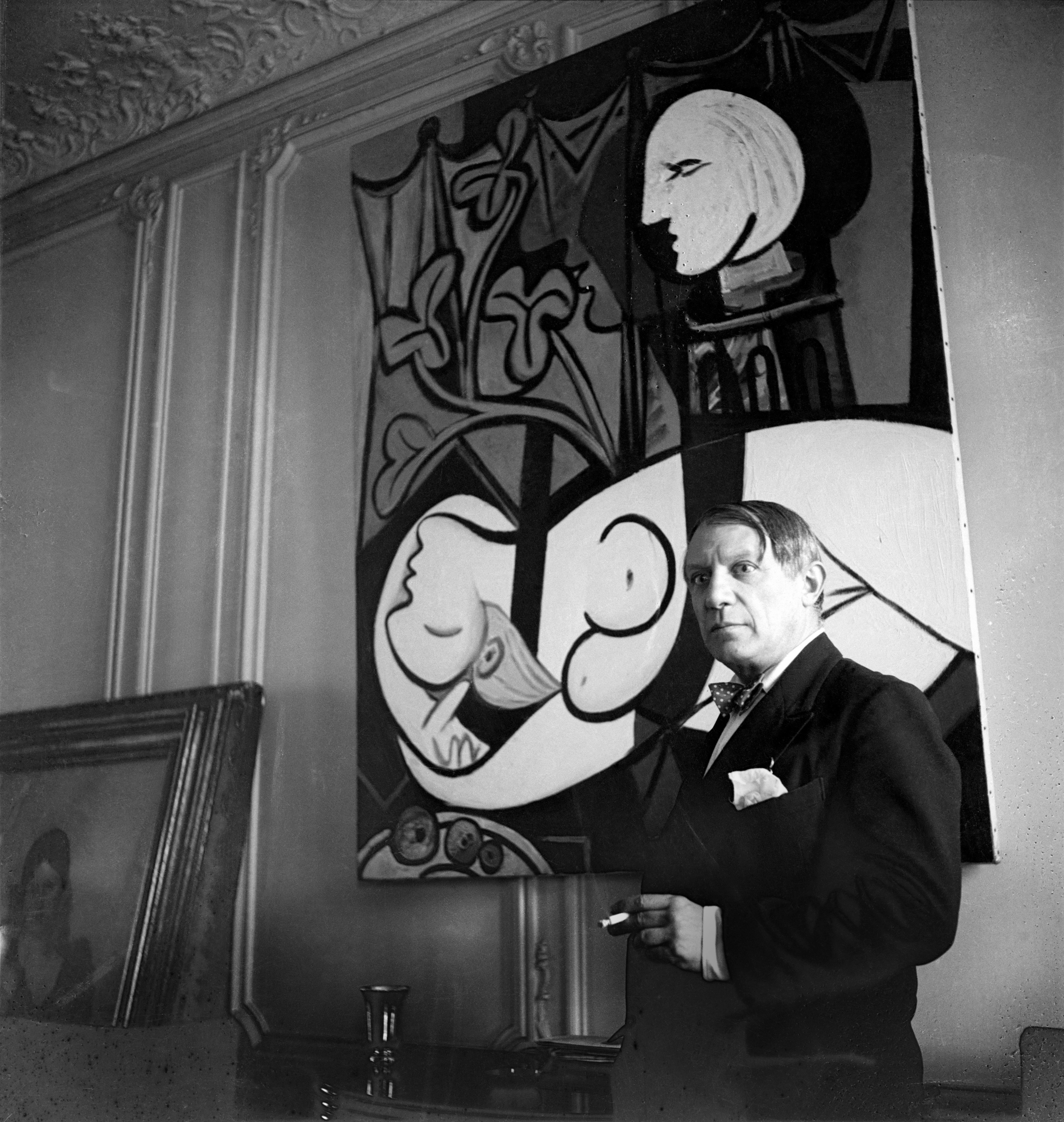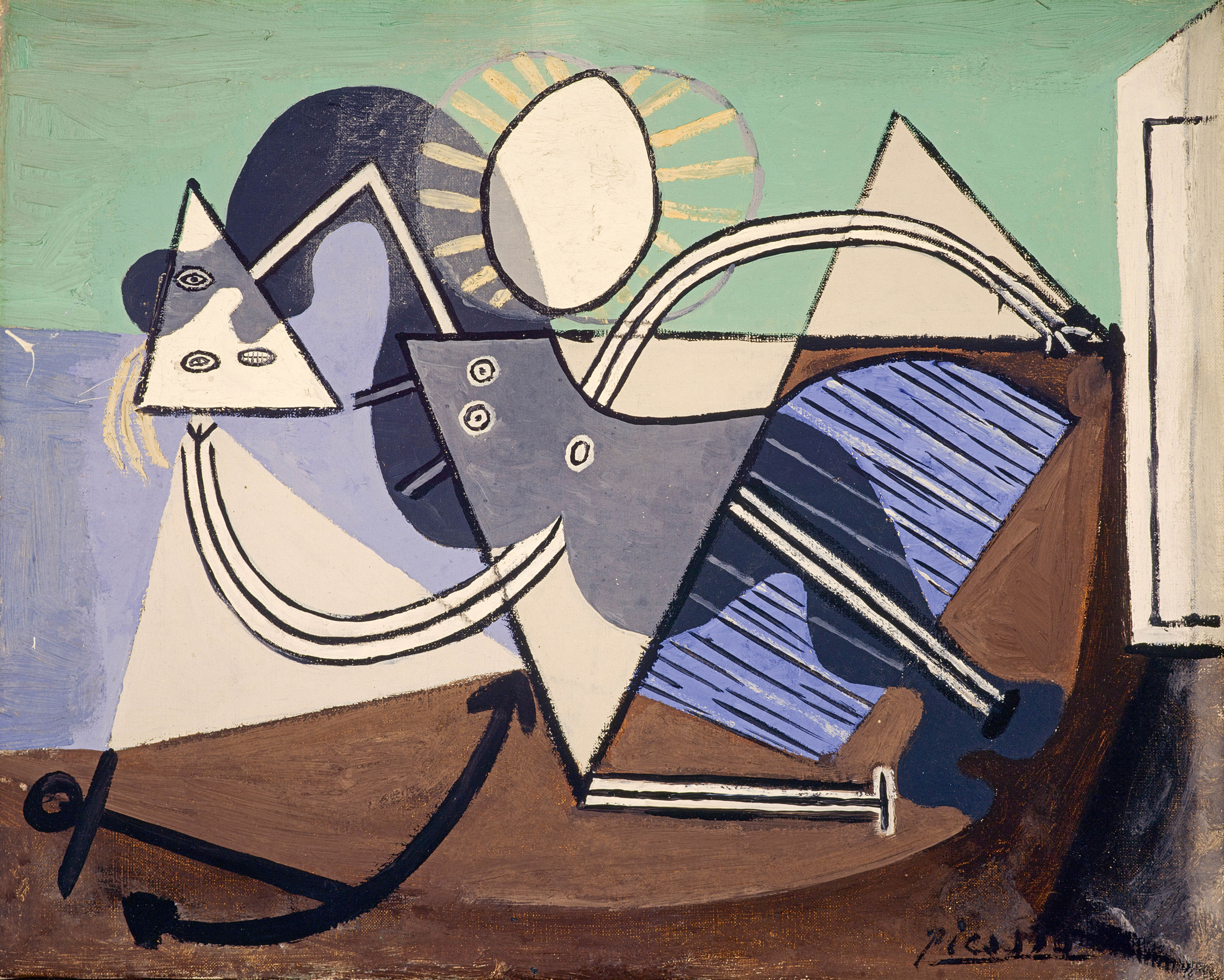On “Picasso 1932: Love, Fame, Tragedy” at Tate Modern, London.
“My dear Philip,” Kingsley Amis wrote to Philip Larkin in April 1973, after learning that Picasso had died. “So Pablo the piss-poor paint-pusher has fallen off the hooks at last, eh? Ho ho ho. Beckett next?”
The British came late to Picasso, but once they did, they came en masse. Before the War, Picasso was almost the private property of the avant-garde in art and, after Guernica (1937), those who believed themselves to be the vanguard in politics. Institutional skepticism about Modernism remained strong after the War. An apocryphon has it that Winston Churchill told Sir Alfred Munnings, the president of the Royal Academy, that if he saw Picasso walking in front of him in Piccadilly, he would kick his backside. When Munnings told this story after an RA dinner in 1949, the war-winning watercolorist wrote to Munnings, denying that he had expressed his reservations about the Catalan Cubist in this manner. Still, it says a lot that Munnings thought the Academicians would appreciate the sentiment, and that they would believe that Churchill might have expressed it.
------------------------------------------------------------------------
The British came late to Picasso, but once they did, they came en masse.
The failure to take Picasso seriously was compounded by an insistence on taking seriously his most frivolous aspect. Always good at gestures, Picasso had joined the French Communist Party after the liberation of Paris in August 1944. His donations propped up the Party into the 1950s. “The Communist Party is strong in this part of London,” the Tate’s director, John Rothenstein, told Richard P. Taylor, the cultural attaché at the American Embassy, in 1952, “and it is possible that they might try to make capital out of the Picasso exhibition.” Rothenstein was quite wrong. once Picasso was a global brand, it was the museums who made capital out of his exhibitions.

After the Tate’s 1960 exhibition, the largest retrospective to that date, Picasso was part of the new celebrity culture. Tatler, coining a phrase, called the 1960 exhibition the first “art block-buster.” Whatever the public thought—and much of it still thinks Picasso was a joker—his wonky eyes and noses were now public knowledge. They were not, however, public property. The major British collections had been slow to accept Picasso as a more than passable paint-pusher. The Bloomsbury Group, who had got in early on Roger Fry’s advice, had bought Picasso’s paintings. So had Roland Penrose, who, in his metamorphosis from Surrealist rebel to insider “Sir Realist,” had laid the ground for the 1960 show with two smaller shows at the ica in 1951 and 1955. But by 1960, the purchasing committees could not afford to buy their way out of their folly.
The Tate did not obtain a major Picasso work until 1965, when Penrose, leaning on his personal friendship with Picasso, negotiated the purchase of The Three Dancers (1925). No British collection owned a complete set of the Vollard Suite until 2011, when the British Museum bought a set with a donation from Hamish Parker, a City investor. Naming the donation in memory of his father, Major Horace Parker, the younger Parker evoked the shade of Kingsley Amis. “Although it might be going too far to suggest that he was a fan of Picasso, he was certainly a fan of the British Museum, especially anything involving education and enlightenment.”
The 1960 blockbuster surveyed five decades of Picasso’s work in just over one hundred paintings. “Picasso 1932,” now at the Tate, is much larger, with more than 160 paintings and sculptures, and describes a single year.1 You could build a substantial Picasso exhibition around any year in his adult life—personally, I’d be delighted by an exhibition composed solely of Joie de Vivre (1946) and a plate of sandwiches—and a slow year for the pint-sized prodigy would have been a year of wonders for almost anyone else. The year 1932 was one of Picasso’s more important—a biographical hinge, and a very good and busy year at the canvas, though perhaps not his best.

The Malagan sex maniac was fifty years old in 1932. His first career retrospective was booked for June, and the first volume of Christian Zervos’s catalogue raisonnée was nearly ready. Fifty is always a tricky age, especially if, like Picasso, you’re trying to keep your wife, the overwrought ex-Diaghilev dancer Olga Khokhlova, from finding out about your girlfriend, the calisthenic blonde teenager Marie-Thérèse Walter. Picasso had picked up Walter outside the Galeries Lafayette department store in 1927, when she was seventeen. once she had passed a horizontal audition, his dealer, Paul Rosenberg, set her up in a flat around the corner from Picasso’s household in the Rue La Boétie. In 1930, Marie-Thérèse moved to the house across the street. This setup, like everything else in Picasso’s life, suited him perfectly. Marie-Thérèse knew nothing about art, Olga knew nothing about Marie-Thérèse, and Picasso got to feel like a desperado every time he dipped his brush.
-------------------------------------------------------------------------
Picasso got to feel like a desperado every time he dipped his brush.
The studio windows steam up in January with La Lecture, a reading from the book of love. Marie-Thérèse’s face is a lilac heart, and the junction of her thighs and pudenda is punningly converted into a book. A few days later, and the diminutive muse-diddler still shows tendresse in Jeune fille à la mandoline. The rhythm of the bulbous mandolin runs through the leaves that sprout from Marie-Thérèse’s right breast, and the scroll-like hands that conform to the arms of her chair. Her head is turned sideways and upwards, her eyes closed in ecstasy or sleep, but Picasso’s placement of the mandolin inside her vagina suggests that the relationship is in trouble. Four days later, in La dormeuse au miroir, he mutilates her nose and mouth as a violent black squiggle.
The rest of the month produces further reveries from the butcher’s shop. In Le Repos, Marie-Thérèse’s limbs are disjointed and the pink of her skin split into white and carmine red. Picasso seems to have had trouble seeing a vagina without thinking of its complementary dentata, and Marie-Thérèse’s smile, so demure when she is asleep, is shark-like when her eyes are open. Before the month is out, he has made two runs at the Surrealist dismemberment of Femme au fauteuil rouge, and worked an erect penis into Marie-Thérèse’s face for Le Rêve. This painting was once owned by the disgraced casino magnate Steve Wynn, who is accused of taking similar liberties with his female employees.
Perhaps unsurprisingly, February is a month of anti-climactic tristesse. But Picasso recharges his batteries in March with a little rite of spring—a couple of stunning Classical meditations, the gorgeous Nu au fauteuil noir, and the exotic complexity of Jeune fille devant un miroir. A rainy break at his country retreat, Boisgeloup in Normandy, elicits some delightful oil sketches with Cézanne in mind, and a dream of Marie-Thérèse stretched out on the Riviera, Nu sur la plage. Picasso pursues that salty theme through April and into May, beaching Marie-Thérèse with an octopus’s tentacles, then bringing his specimen back into the studio as a plateau de fruits de mer, before tenderly noting her deliquescence into callipygously Cycladic form in Femme endormie à l’oreille rouge.
Feeling confident about his retrospective (to be held at the Galeries George Petit), Picasso begins June by sketching Marie-Thérèse’s face as a sculptural medley of zucchini-like phalluses and testes the size of large potatoes. The Tate exhibition, which began at the Musée Picasso in Paris and leans heavily on that museum’s collections, replicates a room from the retrospective. You cannot help but be impressed, but Picasso has already left the building. Two days after his triumph at the Galeries Georges Petit, he visits a Manet retrospective, then resumes his detailed studies of Marie-Thérèse’s bottom.
Summer arrives, daisies sprout around the bottom, and the cycle of enchantment and violence begins again. The tenderness of Femme nue dans un fauteuil rouge (July 27) leads to the wave that crashes onto the flailing swimmer in Nageuse (August 6)—in reality, Marie-Thérèse nearly drowned—but Picasso is on vacation and prefers to be playful. He toys with Matisse in La Sieste (August 18), gives Marie-Thérèse a necklace, a book, and a soupçon of ripped-bodice dignity in Femme tenant un livre (August 22), wittily turns her legs into chicken drumsticks for Baigneuses jouant avec un ballon (August 30), and gets in touch with his inner Poussin for a couple of oil-and-ink sketches in which the muscular faun with the panpipes and the full head of hair resembles fifty-year-old Picasso.
Summer dies. Always one for a quick rentrée in September, Picasso creates a series of dark variations on Isaac Grünewald’s Crucifixion. These reminders that he was the best of Surrealist painters en passant occupy him until October. As the days shorten, his mind returns to Marie-Thérèse’s swimming accident in the summer, and to the spirochetal infection she contracted earlier in the year while swimming in the River Marne. on November 20, he starts Le Sauvetage.
------------------------------------------------------------------------
The motifs of Picasso’s year combine into a snapshot from summer’s unending nightmare.
A woman stands in a boat, hauling up the limp body of a half-drowned Marie-Thérèse, her head reclining as if she were asleep. A mermaid- like swimmer, head and arms breaking the water, helps to lift the body. The motifs of Picasso’s year—the sleeping mistress, the beach, the bathers, the martyred Jesus removed from the cross—combine into a snapshot from summer’s unending nightmare. The green background erupts towards the viewer. Marie-Thérèse’s body is blue with cold, but the sunlight touching her torso as it clears the water sets off a surge of gold as she is resurrected. Exploring the drama, he paints another version later in the month, this time juxtaposing the tragic scene on the water with the banality of ball games on the shore—a modern myth.
I felt used and dirty after “Picasso 1932,” but I loved it. Just when you wonder whether Picasso’s pharaonic phallocentricity will condemn him to the same historical attic as psychoanalysis, Surrealism, and the pop-Modernist novels of Lawrence Durrell, he proves that no one else could smash the tablets of the old tradition and rearrange the fragments with such painterly economy, emotional candor, and mythic clarity. Picasso may have had what Kingsley Amis called “difficulties with girls.” Undeniably, a continuum of coarseness links Picasso to that other macho oligarch of entertainment, Steve Wynn, and the circus of celebrity in which Picasso did a willing turn. Sooner or later, the grandchildren of the people who used to dismiss him as an impostor or a lunatic may add him to the list of “problematic” people to be expunged from the last shreds of the syllabus. That would be a tragedy for all of us.
The dirty dauber turned his difficulties into Le Sauvetage. He, not Marie-Thérèse, was the shark, always moving forward, chomping everything in his path. In Le Sauvetage, we see him move past Surrealism, with its emphasis on words over images, and party politics and psychoanalysis over everything else, and follow his homing instinct onwards and backwards towards the timeless, mythic Mediterranean. The Minotaur awaits in 1933.
1 “Picasso 1932: Love, Fame, Tragedy” opened at Tate Modern, London, on March 8 and remains on view through September 9, 2018.
This article originally appeared in The New Criterion, Volume 36 Number 9, on page 52
Copyright © 2017 The New Criterion | www.newcriterion.com
newcriterion.com/issues/2018/5/picasso-difficulties-with-girls-9783

